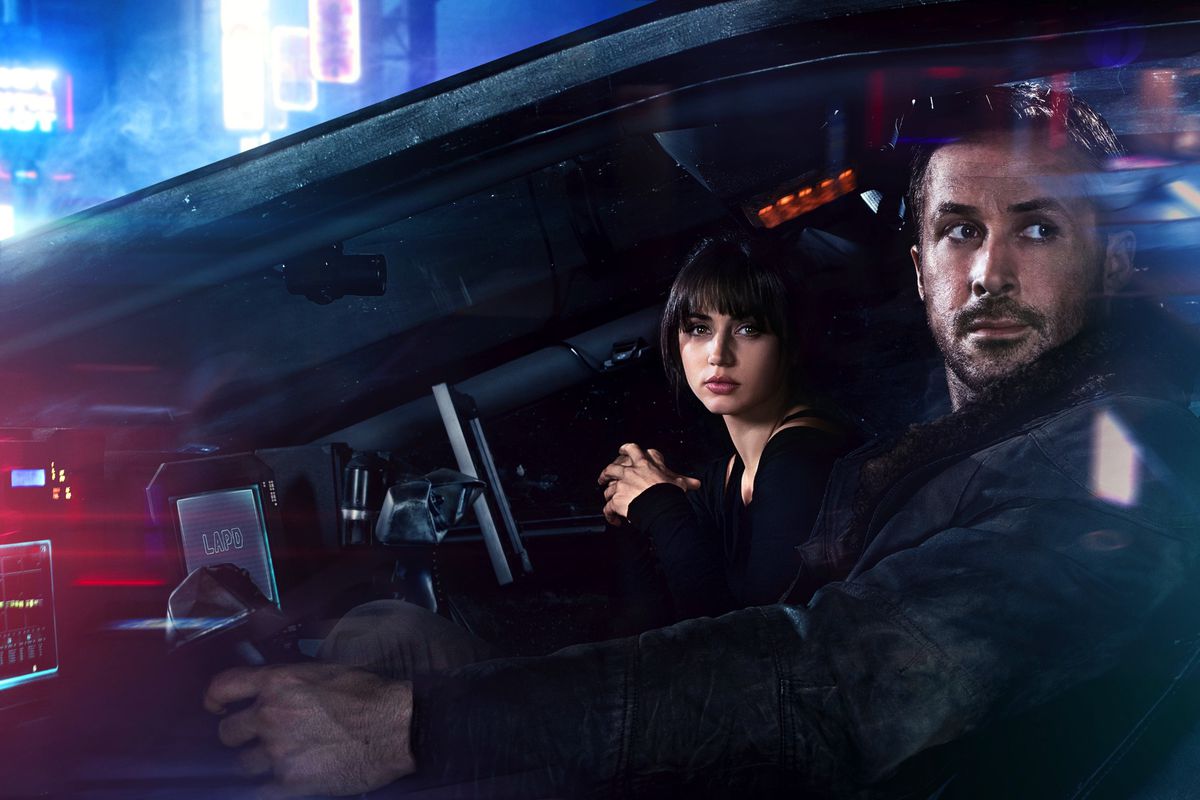Blade Runner 2049 (2017, Dir. Denis Villaneuve):
“I’ve seen things you people wouldn’t believe,” said Rutger Hauer in the first Blade Runner film back in 1982, and indeed, most people at the time didn’t. Pulling from a Philip K. Dick novel that ranks among his most schizoid works (and that’s saying something), director Ridley Scott borrowed the bones of the book’s plot and its ruminative spirit, hammered harder on the noir beats and tech dystopia, and ended up with what we’ve come to know as its own genre: cyberpunk. General audiences at the time regarded it as a mess. (It didn’t help that Harrison Ford was the star, leading viewers to expect another one of those Han Solo-Indiana Jones things.) Roger Ebert summed up the prevailing public opinion in his original review: “Blade Runner is a stunningly interesting visual achievement, but a failure as a story.”
The irony of Blade Runner is that both of those statements are true, and both are the reason the film has taken on a life of its own. Imbued with Scott’s finicky obsession with detail and shot with a script that constantly shifted during production, Blade Runner is a kaleidoscope of a movie: vivid yet fluid, forever awhirl and on the verge of breaking apart. The narrative, like Dick’s book, is at once self-contained and incomplete. It’s into those spaces where we project our own speculations, interpretations and theories, from the prosaic (is Harrison Ford an android or not?) to the metaphysical (what it truly means to be “more human than human,” as the replicants in the movie are claimed to be). The movie invites repeat visits to ponder these questions, and to soak in the art direction, which still pops to this day.
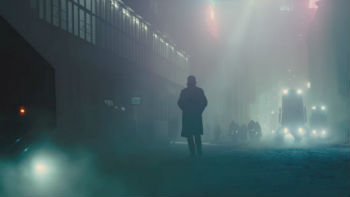 Even the original filmmakers can’t resist returning to Blade Runner — just as our reactions to the film continue to morph, so has the film morphed all by itself, as evidenced by the “director’s cut”s and “final cut”s that have popped up over the decades. A Blade Runner sequel would seem to be a surefire proposition, given the original’s cult status: why not provide answers to some of these long-standing questions, and expand the story past the boundaries of dystopian Los Angeles? On the other hand, given Hollywood’s tendency for over-explanation and redundancy, would a sequel do anything but dilute the power of the original? Surely some questions are better off unanswered.
Even the original filmmakers can’t resist returning to Blade Runner — just as our reactions to the film continue to morph, so has the film morphed all by itself, as evidenced by the “director’s cut”s and “final cut”s that have popped up over the decades. A Blade Runner sequel would seem to be a surefire proposition, given the original’s cult status: why not provide answers to some of these long-standing questions, and expand the story past the boundaries of dystopian Los Angeles? On the other hand, given Hollywood’s tendency for over-explanation and redundancy, would a sequel do anything but dilute the power of the original? Surely some questions are better off unanswered.
Such is the challenge that Scott (as exec producer) and director Denis Villaneuve set for themselves in making Blade Runner 2049. Clearly Villaneuve understands what he’s gotten himself into: at one point in the film, Dr. Ana Stellina (Carla Juri), who seeds replicants with memories, much like a director shepherding actors and sets into place, reflects: “They think it’s about detail. Everything real should be in a mist.” Can a film produced in today’s CGI-enhanced, high-def, what-you-see-is-what-you-get mode of Hollywood filmmaking hope to achieve the same effect as a film 35 years from the misty past, in which clarity was never really the point?
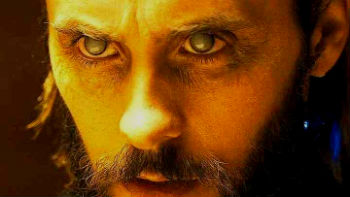 The haunting spectre of the original Blade Runner hangs like a shadow over 2049, which is very much aware of its predecessor. At every turn, it references it, whether it’s audio clips and images from the first movie (some of them enticing, some of them ham-fisted), the decadent neon sprawl of Los Angeles (slightly cleaned up but more desolate than ever), or how Benjamin Wallfisch and Hans Zimmer crib the synthesized washes and quailing notes from the original Vangelis soundtrack. The plot sprouts from the memory of the first film, and as we’ve already learned, memory can be a tricky thing indeed. On a superficial level, the set-up is identical: like Harrison Ford’s Deckard from the 1982 Blade Runner, Ryan Gosling’s Officer K is an LAPD bagman tasked with “retiring” aberrant replicants, and ends up getting far more than he bargained for. When K discovers the bones of a replicant that seemingly gave birth, he finds himself caught between the establishment, represented by his boss Lt. Joshi (Robin Wright), and the capitalist industrial complex, represented by tech guru Niander Wallace (Jared Leto) and his replicant confederate Luv (Sylvia Hoeks). The former wants K to bury all traces of the find: “This will break the world,” she intones gravely (all of the pronouncements in this movie are intoned in grave fashion). The latter sees opportunity for future slave labor, or perhaps even something more, if Wallace’s mutterings about angels and evolution can be believed. Eventually all paths of investigation lead back to Deckard himself, long since gone and presumed dead. Is Deckard a replicant? The precise answer won’t be revealed here, but suffice to say Villaneuve honors the original Blade Runner‘s ambiguity on the matter.
The haunting spectre of the original Blade Runner hangs like a shadow over 2049, which is very much aware of its predecessor. At every turn, it references it, whether it’s audio clips and images from the first movie (some of them enticing, some of them ham-fisted), the decadent neon sprawl of Los Angeles (slightly cleaned up but more desolate than ever), or how Benjamin Wallfisch and Hans Zimmer crib the synthesized washes and quailing notes from the original Vangelis soundtrack. The plot sprouts from the memory of the first film, and as we’ve already learned, memory can be a tricky thing indeed. On a superficial level, the set-up is identical: like Harrison Ford’s Deckard from the 1982 Blade Runner, Ryan Gosling’s Officer K is an LAPD bagman tasked with “retiring” aberrant replicants, and ends up getting far more than he bargained for. When K discovers the bones of a replicant that seemingly gave birth, he finds himself caught between the establishment, represented by his boss Lt. Joshi (Robin Wright), and the capitalist industrial complex, represented by tech guru Niander Wallace (Jared Leto) and his replicant confederate Luv (Sylvia Hoeks). The former wants K to bury all traces of the find: “This will break the world,” she intones gravely (all of the pronouncements in this movie are intoned in grave fashion). The latter sees opportunity for future slave labor, or perhaps even something more, if Wallace’s mutterings about angels and evolution can be believed. Eventually all paths of investigation lead back to Deckard himself, long since gone and presumed dead. Is Deckard a replicant? The precise answer won’t be revealed here, but suffice to say Villaneuve honors the original Blade Runner‘s ambiguity on the matter.
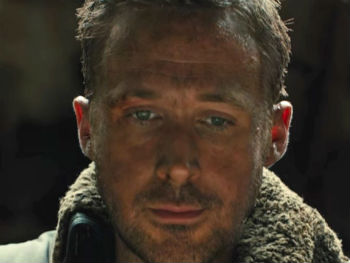 There’s a certain poignancy in how the events and characters from the first Blade Runner struggle to emerge in this more clouded, downtrodden version of the future. No longer are androids “more human than human”; now they’re “as human as you want them to be.” Pulpy zest has given way to solemn melancholy, and nobody embodies the tone more than K himself, who is actually a replicant hunting down his own kind (or as he rationalizes: “I don’t retire my own kind, because we don’t run. Only older models do”). Later events suggest that K might actually be human after all (cue Pinocchio parallels), but the implications of the human-android divide, including early scenes in which human prejudice against robots is on display, are only briefly touched upon. It’s left up to Gosling to supply his character with depth. While jokes will be made about him being cast as a robot — some will see the role as the fulfillment of his career — he’s deepened as an actor in recent years. His baby-doll face might still be a beautiful blank, but it’s gained some heft, and his enigmatic gaze can sharpen or go soulful on a dime. Outdoing the script, he’s entirely believable as an android undergoing an emotional meltdown, or a human experiencing a messy awakening.
There’s a certain poignancy in how the events and characters from the first Blade Runner struggle to emerge in this more clouded, downtrodden version of the future. No longer are androids “more human than human”; now they’re “as human as you want them to be.” Pulpy zest has given way to solemn melancholy, and nobody embodies the tone more than K himself, who is actually a replicant hunting down his own kind (or as he rationalizes: “I don’t retire my own kind, because we don’t run. Only older models do”). Later events suggest that K might actually be human after all (cue Pinocchio parallels), but the implications of the human-android divide, including early scenes in which human prejudice against robots is on display, are only briefly touched upon. It’s left up to Gosling to supply his character with depth. While jokes will be made about him being cast as a robot — some will see the role as the fulfillment of his career — he’s deepened as an actor in recent years. His baby-doll face might still be a beautiful blank, but it’s gained some heft, and his enigmatic gaze can sharpen or go soulful on a dime. Outdoing the script, he’s entirely believable as an android undergoing an emotional meltdown, or a human experiencing a messy awakening.
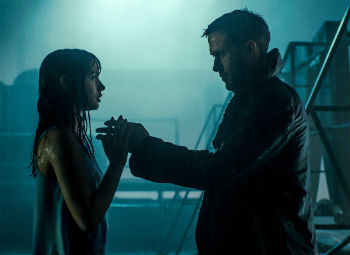 Whatever flickers of feeling the movie has are restricted mainly to K’s interactions with Joi (Ana de Armas), the holographic companion who inhabits his house and later joins him on his adventures. He bestows on her the freedom of movement via a software upgrade; she provides him with a first name of Joe (aka Joseph K, shout out to Mr. Kafka!). Blade Runner 2049‘s most poetic moments are reserved for Joi — venturing into the rain for the first time alongside K, her throes of passion interrupted when a phone call freezes her program, and a later menage a trois in which she superimposes herself over a replicant prostitute. These passages, and de Armas’ guileless performance, come the closest to approximating the stunned romance at the heart of the original film. Otherwise, sensuousness is mainly restricted to holographic advertisements and frozen statues.
Whatever flickers of feeling the movie has are restricted mainly to K’s interactions with Joi (Ana de Armas), the holographic companion who inhabits his house and later joins him on his adventures. He bestows on her the freedom of movement via a software upgrade; she provides him with a first name of Joe (aka Joseph K, shout out to Mr. Kafka!). Blade Runner 2049‘s most poetic moments are reserved for Joi — venturing into the rain for the first time alongside K, her throes of passion interrupted when a phone call freezes her program, and a later menage a trois in which she superimposes herself over a replicant prostitute. These passages, and de Armas’ guileless performance, come the closest to approximating the stunned romance at the heart of the original film. Otherwise, sensuousness is mainly restricted to holographic advertisements and frozen statues.
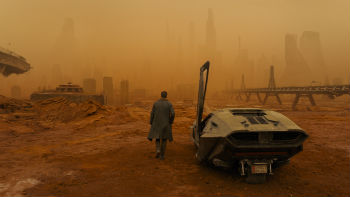 Elsewhere, the film aims to stun us with the grandeur of its production design and the far-reaching implications of its plot. On the former count, at least, it’s an impressive work. Soaring above fractured plains, catching the nighttime twinkle of snowflakes falling on downtown, getting lost in the trash-dump detritus of what was once San Diego, and invading the baroque temples of a Las Vegas scorched by nuclear fire, Roger Deakins’ cinematography owns the show, and although the art-deco flamboyance of the original Blade Runner is sorely missed, there’s no denying that care and craftsmanship have gone into the film’s look. The plot is a different matter, however. Villaneueve wants Blade Runner 2049 to be a honest-to-goodness detective story with provocative, world-altering stakes. (He’s no stranger to subtext either — when two characters are named Joi and Luv, for example, you know some big-time allegory is going on.) Admirable as his ambition is, his pacing is ponderous rather than confident, and the picture takes far too long to waddle up to revelations that aren’t especially exciting. You could argue Villaneuve is more muscular and substantial than Scott as a director; he’s also more monochromatic. Is substance a prime requisite for this kind of movie, anyway? Decry Scott’s flashy MTV-era aesthetics all you want, but in 1982 he had a surer grasp of composition, camera movement and transition. In 2049 we’re awkwardly shot-put from one scene to the next, and although the original Blade Runner lingered over its cityscapes a fair amount, Villaneueve takes it to the next level here, filming endless, static stretches of scenery like a kid all too eager to show off every toy in his box.
Elsewhere, the film aims to stun us with the grandeur of its production design and the far-reaching implications of its plot. On the former count, at least, it’s an impressive work. Soaring above fractured plains, catching the nighttime twinkle of snowflakes falling on downtown, getting lost in the trash-dump detritus of what was once San Diego, and invading the baroque temples of a Las Vegas scorched by nuclear fire, Roger Deakins’ cinematography owns the show, and although the art-deco flamboyance of the original Blade Runner is sorely missed, there’s no denying that care and craftsmanship have gone into the film’s look. The plot is a different matter, however. Villaneueve wants Blade Runner 2049 to be a honest-to-goodness detective story with provocative, world-altering stakes. (He’s no stranger to subtext either — when two characters are named Joi and Luv, for example, you know some big-time allegory is going on.) Admirable as his ambition is, his pacing is ponderous rather than confident, and the picture takes far too long to waddle up to revelations that aren’t especially exciting. You could argue Villaneuve is more muscular and substantial than Scott as a director; he’s also more monochromatic. Is substance a prime requisite for this kind of movie, anyway? Decry Scott’s flashy MTV-era aesthetics all you want, but in 1982 he had a surer grasp of composition, camera movement and transition. In 2049 we’re awkwardly shot-put from one scene to the next, and although the original Blade Runner lingered over its cityscapes a fair amount, Villaneueve takes it to the next level here, filming endless, static stretches of scenery like a kid all too eager to show off every toy in his box.
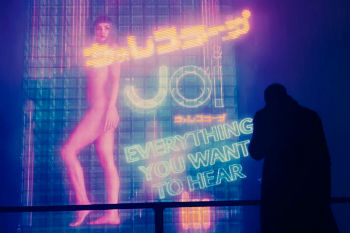 Of course the plot’s shortcomings aren’t solely Villaneuve’s fault: the seeds of the story are laid in the “final cut” of Blade Runner when replicant Roy Batty confronts his inventor with the line: “I want more life, father.” (It’s a re-dub from the original version of the movie, in which he said “fucker.”) Blade Runner 2049 carries on from that hint, with the emphasis squarely on parents and children, both literal and figurative. We’ve moved backwards, from postmodern speculative sci-fi into near-Biblical realms, as a missing replicant child becomes the linchpin of an incipient war between androids and humans. “You’ve never seen a miracle,” a rebellious replicant says to K early on, and with all the talk of miracle births, the coming of a revolution, and the references to angels, it’s clear that Scott is trying to impose a mythology on this property, similar to what he has attempted to graft onto the Alien franchise. All this po-faced mythologizing suits Villaneueve just fine — he’s smitten with the grand gesture, the expansive shot, the earnestness of it all. Too bad he can’t find a way to sketch in his characters as colorfully as the original Blade Runner did. Most of the supporting actors have their mouths stuffed with dialogue about destiny and philosophy, with Jared Leto’s Wallace getting the worst of it. Wafting his way through the movie, he’s underwhelming, but what could any actor do with dialogue such as “You do not know what pain is yet. You will”?
Of course the plot’s shortcomings aren’t solely Villaneuve’s fault: the seeds of the story are laid in the “final cut” of Blade Runner when replicant Roy Batty confronts his inventor with the line: “I want more life, father.” (It’s a re-dub from the original version of the movie, in which he said “fucker.”) Blade Runner 2049 carries on from that hint, with the emphasis squarely on parents and children, both literal and figurative. We’ve moved backwards, from postmodern speculative sci-fi into near-Biblical realms, as a missing replicant child becomes the linchpin of an incipient war between androids and humans. “You’ve never seen a miracle,” a rebellious replicant says to K early on, and with all the talk of miracle births, the coming of a revolution, and the references to angels, it’s clear that Scott is trying to impose a mythology on this property, similar to what he has attempted to graft onto the Alien franchise. All this po-faced mythologizing suits Villaneueve just fine — he’s smitten with the grand gesture, the expansive shot, the earnestness of it all. Too bad he can’t find a way to sketch in his characters as colorfully as the original Blade Runner did. Most of the supporting actors have their mouths stuffed with dialogue about destiny and philosophy, with Jared Leto’s Wallace getting the worst of it. Wafting his way through the movie, he’s underwhelming, but what could any actor do with dialogue such as “You do not know what pain is yet. You will”?
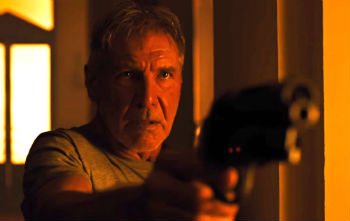 The film does receive a jolt in its third act with the arrival of Ford. More emotionally wounded than he was in the original film, coarsened by loss and thirty years of hiding out, he’s the movie’s most identifiably human presence, all the mysteries about his true nature be damned. In his slyest moment, he’s punching out Gosling’s K within minutes of meeting him, as a hologram of Elvis Presley croons “Can’t Help Falling in Love with You” in the background. Ford also provides the film’s most Dickian bit of dialogue, when Gosling asks him whether his dog is real. “I dunno,” he shrugs. “Ask him.” Such bursts of absurdity and head-spinning uncertainty are rare in Blade Runner 2049 — the further the film trudges on, the less beguiling its central mysteries become. The finale couldn’t be more botched: a waterlogged punch-up in a sinking transport, a final sacrifice by an android that is a pale echo of a similar moment in the original Blade Runner (Villanueve plays dirty pool by superimposing Vangelis’ famous “Tears in Rain” track over the scene), and a few hints about the coming war which will no doubt take place in the next sequel (although judging by the opening weekend receipts, a sequel may not be in the cards — if nothing else, Blade Runner 2049 seems destined to match its predecessor when it comes to initial box office failure).
The film does receive a jolt in its third act with the arrival of Ford. More emotionally wounded than he was in the original film, coarsened by loss and thirty years of hiding out, he’s the movie’s most identifiably human presence, all the mysteries about his true nature be damned. In his slyest moment, he’s punching out Gosling’s K within minutes of meeting him, as a hologram of Elvis Presley croons “Can’t Help Falling in Love with You” in the background. Ford also provides the film’s most Dickian bit of dialogue, when Gosling asks him whether his dog is real. “I dunno,” he shrugs. “Ask him.” Such bursts of absurdity and head-spinning uncertainty are rare in Blade Runner 2049 — the further the film trudges on, the less beguiling its central mysteries become. The finale couldn’t be more botched: a waterlogged punch-up in a sinking transport, a final sacrifice by an android that is a pale echo of a similar moment in the original Blade Runner (Villanueve plays dirty pool by superimposing Vangelis’ famous “Tears in Rain” track over the scene), and a few hints about the coming war which will no doubt take place in the next sequel (although judging by the opening weekend receipts, a sequel may not be in the cards — if nothing else, Blade Runner 2049 seems destined to match its predecessor when it comes to initial box office failure).
“I became very good at imagining,” says Dr. Stelline, and Villaneueve, Scott and company are very good at imagining some intriguing eye candy. But what of the characters and stories that populate this environment? Blade Runner 2049 tries to have it both ways, genuflecting at the altar of the original film by bringing back Ford (along with other surprise cameos) while also dragging the story away from cyberpunk towards mythic opera. In the end, neither approach holds you in thrall. “A revolution is coming,” we’re told, yet this world seems too melancholic, too insular, too fatalistic, to support such barnstorming. As commendable as the filmmakers’ efforts might be, the movie proves that you can’t go back to 1982 again. Why revisit 1982, anyway, when the original Blade Runner is still very much present and among us, as inscrutable and engrossing as it has ever been? Unlike replicants, some memories, and movies, are made to last. ■

